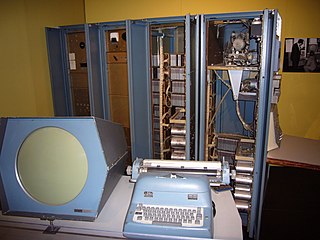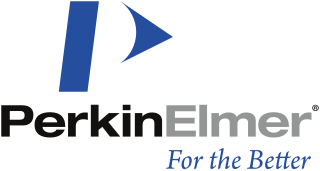
A minicomputer, or colloquially mini, is a type of smaller general-purpose computer developed in the mid-1960s and sold at a much lower price than mainframe and mid-size computers from IBM and its direct competitors. In a 1970 survey, The New York Times suggested a consensus definition of a minicomputer as a machine costing less than US$25,000, with an input-output device such as a teleprinter and at least four thousand words of memory, that is capable of running programs in a higher level language, such as Fortran or BASIC.

Programmed Data Processor (PDP), referred to by some customers, media and authors as "Programmable Data Processor," is a term used by the Digital Equipment Corporation from 1957 to 1990 for several lines of minicomputers.

The PDP–11 is a series of 16-bit minicomputers sold by Digital Equipment Corporation (DEC) from 1970 into the late 1990s, one of a set of products in the Programmed Data Processor (PDP) series. In total, around 600,000 PDP-11s of all models were sold, making it one of DEC's most successful product lines. The PDP-11 is considered by some experts to be the most popular minicomputer.

In computing, time-sharing is the sharing of a computing resource among many tasks or users. It enables multi-tasking by a single user or enables multiple-user sessions.

A superminicomputer, colloquially supermini, is a high-end minicomputer. The term is used to distinguish the emerging 32-bit architecture midrange computers introduced in the mid to late 1970s from the classical 16-bit systems that preceded them. The development of these computers was driven by the need of applications to address larger memory. The term midicomputer had been used earlier to refer to these systems. Virtual memory was often an additional criteria that was considered for inclusion in this class of system. The computational speed of these machines was significantly greater than the 16-bit minicomputers and approached the performance of small mainframe computers. The name has at times been described as a "frivolous" term created by "marketeers" that lacks a specific definition. Describing a class of system has historically been seen as problematic: "In the computer kingdom, taxonomic classification of equipment is more of a black art than a science." There is some disagreement about which systems should be included in this class. The origin of the name is uncertain.

The history of computing hardware starting at 1960 is marked by the conversion from vacuum tube to solid-state devices such as transistors and then integrated circuit (IC) chips. Around 1953 to 1959, discrete transistors started being considered sufficiently reliable and economical that they made further vacuum tube computers uncompetitive. Metal–oxide–semiconductor (MOS) large-scale integration (LSI) technology subsequently led to the development of semiconductor memory in the mid-to-late 1960s and then the microprocessor in the early 1970s. This led to primary computer memory moving away from magnetic-core memory devices to solid-state static and dynamic semiconductor memory, which greatly reduced the cost, size, and power consumption of computers. These advances led to the miniaturized personal computer (PC) in the 1970s, starting with home computers and desktop computers, followed by laptops and then mobile computers over the next several decades.

The IBM 5100 Portable Computer is one of the first portable computers, introduced in September 1975, six years before the IBM Personal Computer, and eight before the first successful IBM compatible portable computer, the Compaq Portable. It was the evolution of a prototype called the SCAMP that was developed at the IBM Palo Alto Scientific Center in 1973. Whether considered evolutionary from SCAMP or revolutionary, it still needed to be plugged into an electric socket.

The Teletype Model 33 is an electromechanical teleprinter designed for light-duty office use. It is less rugged and cost less than earlier Teletype models. The Teletype Corporation introduced the Model 33 as a commercial product in 1963, after it had originally been designed for the United States Navy. The Model 33 was produced in three versions:

PerkinElmer, Inc., previously styled Perkin-Elmer, is an American global corporation that was founded in 1937 and originally focused on precision optics. Over the years it went into and out of several different businesses via acquisitions and divestitures; these included defense products, semiconductors, computer systems, and others. By the 21st century, PerkinElmer was focused in the business areas of diagnostics, life science research, food, environmental and industrial testing. Its capabilities include detection, imaging, informatics, and service. It produced analytical instruments, genetic testing and diagnostic tools, medical imaging components, software, instruments, and consumables for multiple end markets. PerkinElmer was part of the S&P 500 Index and operated in 190 countries.

Sixth Edition Unix, also called Version 6 Unix or just V6, was the first version of the Unix operating system to see wide release outside Bell Labs. It was released in May 1975 and, like its direct predecessor, targeted the DEC PDP-11 family of minicomputers. It was superseded by Version 7 Unix in 1978/1979, although V6 systems remained in regular operation until at least 1985.

The Model 7/32 and Model 8/32 were 32-bit minicomputers introduced by Perkin-Elmer after they acquired Interdata, Inc., in 1973. Interdata computers are primarily remembered for being the first 32-bit minicomputers under $10,000. The 8/32 was a more powerful machine than the 7/32, with the notable feature of allowing user-programmable microcode to be employed.

Am2900 is a family of integrated circuits (ICs) created in 1975 by Advanced Micro Devices (AMD). They were constructed with bipolar devices, in a bit-slice topology, and were designed to be used as modular components each representing a different aspect of a computer control unit (CCU). By using the bit slicing technique, the Am2900 family was able to implement a CCU with data, addresses, and instructions to be any multiple of 4 bits by multiplying the number of ICs. One major problem with this modular technique was that it required a larger number of ICs to implement what could be done on a single CPU IC. The Am2901 chip included an arithmetic logic unit (ALU) and 16 4-bit processor register slices, and was the "core" of the series. It could count using 4 bits and implement binary operations as well as various bit-shifting operations. The Am2909 was a 4-bit-slice address sequencer that could generate 4-bit addresses on a single chip, and by using n of them, it was able to generate 4n-bit addresses. It had a stack that could store a microprogram counter up to 4 nest levels, as well as a stack pointer.
Systems Engineering Laboratories was a manufacturer of minicomputers in Fort Lauderdale, Florida. It was one of the first 32-bit realtime computer system manufacturers. Realtime computers are used for process control and monitoring.

Midrange computers, or midrange systems, were a class of computer systems that fell in between mainframe computers and microcomputers.

The 74181 is a 4-bit slice arithmetic logic unit (ALU), implemented as a 7400 series TTL integrated circuit. Introduced by Texas Instruments in February 1970, it was the first complete ALU on a single chip. It was used as the arithmetic/logic core in the CPUs of many historically significant minicomputers and other devices.
In computer architecture, 16-bit integers, memory addresses, or other data units are those that are 16 bits wide. Also, 16-bit central processing unit (CPU) and arithmetic logic unit (ALU) architectures are those that are based on registers, address buses, or data buses of that size. 16-bit microcomputers are microcomputers that use 16-bit microprocessors.

Concurrent Computer Corporation was an American computer company, in existence from 1985 to 2017, that made real-time computing and parallel processing systems. Its products powered a variety of applications including process control, simulators, data acquisition, and video-on-demand. It was based in Monmouth County, New Jersey, initially, and then later in Fort Lauderdale, Florida and Duluth, Georgia.

The PDP-8/e was a model of the PDP-8 line of minicomputers, designed by the Digital Equipment Corporation to be a general purpose computer that inexpensively met the needs of the average user while also being capable of modular expansion to meet the more specific needs of advanced user.















